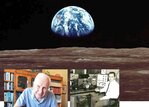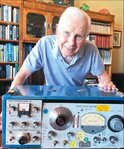




Young aerospace engineer Ron Botsko wasn’t in the headlines during America’s race to space and triumphant landing on the moon 50 years ago today.
But he helped assure the safety and integrity of the Apollo structures.
Through nondestructive testing (NDT) developments he helped make sure the spacecrafts safely launched and returned to Earth.
No small feat.
Botsko, 81, a Harbor Lakes resident, is highly regarded in his field that played a key role in the Saturn and Apollo moon missions and other aerospace programs.
‘Everybody was dedicated to get this thing to the moon. I was lucky to be in the right spot at the right time.’
–Ron Botsko
He invented and patented a variety of nondestructive testing instruments and methods involving ultrasonic and electromagnetic principles.
“My job was the safety of people and the structures,” Botsko said. “We didn’t want failure. Due to narrow margins the quality of the projects could not be compromised.”
Botsko is joining fellow Americans in remembering the golden anniversary of one of man’s most remarkable achievements – walking on the moon July 20, 1969.
“It was a race with Russia to get to the moon,” Botsko said. “It was a tremendous technological effort.
“It was teamwork. Everybody was dedicated to get this thing to the moon. I was lucky to be in the right spot at the right time.”
Botsko watched the Apollo 11 moon landing on a small black and white Zenith TV at a mentor’s house in Pasadena, California. They and a half-billion people were hypnotized by what they were seeing on their television sets.
BORN IN STEEL TOWN
Botsko was born Sept. 4, 1937 in the midst of 26 miles of noisy, smelly steel mills in Youngstown, Ohio.
He enjoyed sports, playing basketball and baseball. Later in life he became an avid snow skier, both recreational and as a medal-winning slalom racer.
Botsko would have been a third-generation steel mill worker but realized it wasn’t the career for him.
He got out as fast as he could.
He entered the prestigious Case Institute of Technology in Cleveland.
During the first snow Botsko asked one of his classmates, “What’s that white stuff?”
“That’s snow,” the classmate replied.
“Where I come from it’s either yellow, brown or black,” Botsko jokingly said.
Botsko didn’t make superior grades but studied hard and earned an engineering degree in 1959.
He almost didn’t make it though. He lacked money for the final semester and was packed and ready to return home when one of his friends spotted him and asked where he was going.
Botsko told him, but the friend insisted that he stay, and paid the balance that enabled Botsko to remain and get his degree.
“Not for that I might still be in Youngstown,” Botsko said with a smile.
But Botsko “escaped” to Southern
| MAYBE THE ‘WRONG STUFF’
Ron Botsko was at a party one night in California chatting with famous test pilot Scott Crossfield (of “The Right Stuff ”fame). Both had drinks in hand.
“We sat on the floor next to each other, and they’re all celebrating,” Botsko remembered. “He (Scott) said, ‘Ron, they don’t seem to want me and Chuck Yeager. We would have been fine astronauts. You know, I would even go to the moon on a one-way trip.
“I said, ‘Scotty, give me that drink.’”
California and “landed in this glorious thing called aerospace.”
He visited North American Aviation, the company developing many aerospace vehicles, including the Apollo, Saturn and lunar excursion modules, B-70 bomber and X-15 rocket plane.
“They looked at my education and hired me on the spot. I walked into pure luck,” the modest Botsko said.
He was only in his early 20s at the time.
His job was to develop nondestructive testing methods and instrumentations.
“We didn’t have the tools,” Botsko said. “They’d come in and say ‘help, help.’ We had to invent stuff quickly because the project had to move in.”
Botsko said he was blessed to have several outstanding mentors. “They were world renown,” he said.
The young inventor moved on and became general manager of Microwave Instruments Company. But he decided that he had enough business knowledge to start his own company.
In 1971 he formed NDT Inc. in his bedroom closet. The company flourished, developing about 19 cutting-edge instruments in 18 years for a spectrum of industries, including aerospace, nuclear, petrochemical, the military and NASA.
BEER CAN TESTING
A beer manufacturer even sought Botsko’s help to test the thickness of its beer cans.
“They wanted to make them as thin as possible but not too thin because they would break,” he explained.
Unexpectedly, DuPont came calling and bought the company in 1988. Botsko stayed on as a director for several years until semi-retiring in 1992. He was only in his early 50s, in prime shape to work on his golf game.
Botsko has lectured extensively in his professional field of nondestructive testing. He was presented various major awards and was recognized worldwide. He was a California board certified licensed professional engineer in two different engineering fields and is honored as a Fellow in the American Society for Nondestructive Testing (ASNT). He was also recognized as a prominent engineer by the Library of Congress.
Botsko may be making another trip to Paris, his favorite city in the world. He was chosen as part of a 10-member engineering team to help rebuild the burned Notre Dame Cathedral.
Just like in the early aerospace days, Botsko will lean on his comrades.
“Teamwork, teamwork,” he says. “You don’t do anything yourself.”
FRIENDLY TOWN
Botsko and his wife Billie moved to Granbury to be near their daughter and family.
Ron and Billie live in a Lake Gran-bury waterfront home. They have developed many friendships in the Granbury area.
“The wonderful people is what kept us in Granbury,” Botsko said.
An example, he said, was his first trip to a Walmart. It was in Granbury. “A young lady stopped and smiled and said, ‘Good morning!’ She was just being kind.”
Botsko doesn’t play as much golf these days, but he and Billie play couples bridge and he plays competitive duplicate bridge.
In Botsko’s study at home hangs a plaque and a piece of a charred heat shield from one of the Apollo missions. NASA presented it to him in the early 1970s in appreciation of his contributions.
“It was a wonderful life and still is,” he says with a broad smile.
editor@hcnews.com | 817-573-7066, ext. 245